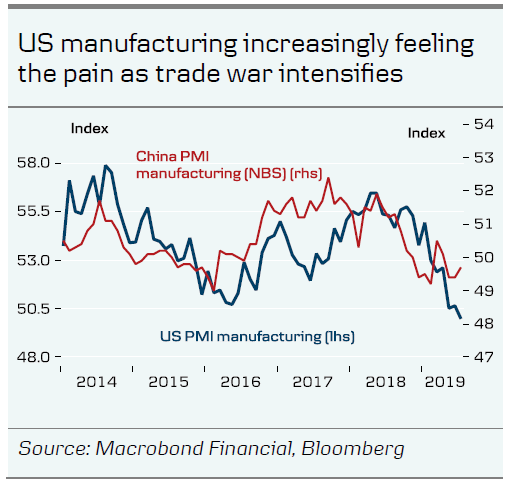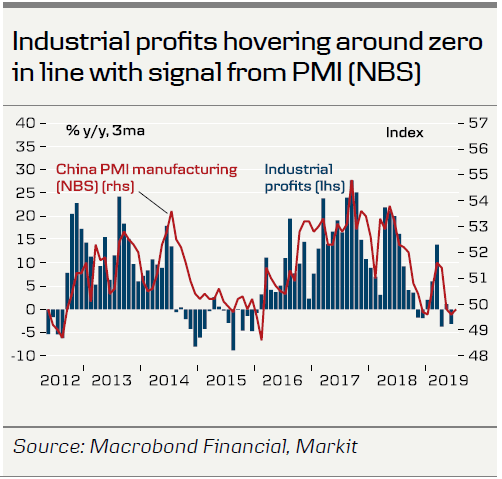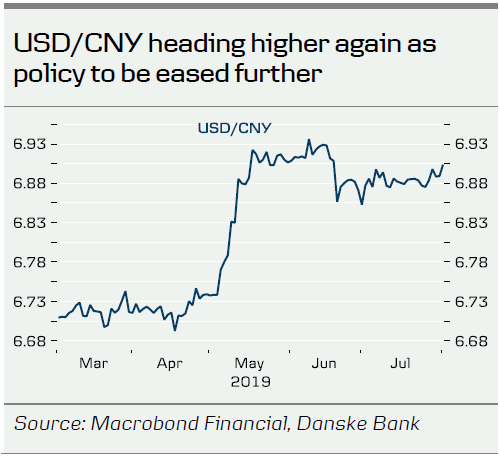- A trade deal keeps moving further away, as Trump ends ceasefire after a month and threatens with even more tariffs
- Chinese data points to stabilisation at a low level, more stimulus coming after trade war escalation
- China’s new tech board STAR got off to a strong start
‘Maximum pressure’ strategy continues despite little success
Trump made another surprise move in the trade war yesterday by putting 10% tariffs on another USD300bn worth of Chinese exports. Interestingly, he also tweeted that the US looks forward to continuing the ‘positive dialogue ‘ with China on a comprehensive trade deal.
The tariff announcement was probably a response to the high-level trade talks in Shanghai this week, where China likely showed little movement. Even so, a White House statement called the talks ‘constructive’. The last time it used this word was right before the previous tariff increase in early May, so it might be a warning sign in the future. Talking to reporters yesterday, Trump warned that tariffs could go to 25% or higher.
It is quite clear that China does not agree with Trump that the dialogue is positive. China’s Foreign Minister Wang Yi said overnight ‘adding tariffs is definitely not a constructive way to solve the economic and trade frictions’. Global Times editor Hu Xijin tweeted that ‘new tariffs will by no means bring closer a deal that the US wants, it will only make it further away’. He added, ‘I think the Chinese will no longer give priority to controlling trade war scale, they will focus on the national strategy under a prolonged trade war’.
The Commerce Ministry warned of retaliation on Friday: ‘China strongly opposes and will take necessary measures to defend its interest if the US imposes an additional 10% tariff on USD300 billion Chinese imports ‘.
In another sign that Trump is getting impatient, he lashed out at China earlier this week in a long tweet thread , stating that China’s growth was the lowest in 27 years and warning China of stalling talks to the other side of the US election: ‘if & when I win, the deal that they get will be much tougher ‘. The Chinese Foreign Ministry spokesperson Hua Chunying shot back the following day saying ‘at this time, for the US to show an intention of using maximum pressure is meaningless ‘.
Last week Trump met CEOs from Cisco, Intel, Qualcomm and other leading US tech companies. The CEOs urged quick licensing decisions on sales to Huawei . The major chipmaker Qualcomm took a hit in the stock market this week following weaker-than-expected third-quarter sales and a warning that the Huawei ban had created headwinds in the Chinese market. NikkeiAsianReview cited sources that Huawei is set to leapfrog Samsung, Apple and Qualcomm with the launch of two of the world’s most advanced microchips for mobile phones.
Comment. It is quite a big gamble from Trump to raise tariffs further and I think he is overplaying his hand. The maximum pressure strategy has not been successful so far and it will only make it harder for China to make a deal. The last thing the leadership can afford domestically is to make a deal that looks like caving into blackmail by Trump. In addition, the damage on the US economy will increasingly go up and farmers, US businesses and consumers will feel the heat from this. It puts the pressure back on Trump.
As indicated by the spokesperson, China will retaliate in some form. Restrictions on rare earth metals might start to be implemented; especially if the ban on US exports to Huawei is not lifted, which might very well be a consequence of the escalation. A consumer boycott is still a weapon China has not encouraged yet, but it could come in some form. Not least if Trump decides to go all in and raise tariffs even further. We still do not see it as likely that China will start selling out of US Treasuries as it can easily backfire.
It is increasingly likely that this trade conflict will drag on for a long time and possibly well into next year. China’s strategy seems to prepare for a long trade war and maybe wait it out until the other side of the election in November 2020. China believes it has the tools to stabilise the economy through stimulus to compensate for the trade drag and it is very likely we will see new stimulus announced soon.
A key determinant is likely to be the US election, not least how farmers respond in polls. Their votes are key in some of the swing states (Iowa, Wisconsin, Ohio) and they have expressed a rising concern that their biggest market could be threatened for many years if a deal is not reached soon. Many farmers are struggling economically due to low prices and adverse weather on top of the trade war. It seems China is betting that Trump will eventually blink as we move closer to the election.
Chinese data point to stabilisation at low level, stimulus coming
PMI data for July this week were slightly better than expected pointing to some stabilisation but at a subdued growth level (see charts). There is still no sign of a hard landing, though, which is the same signal from metal markets that have held up reasonably well. Profit growth is hovering around zero due to the economic slowdown. A politburo meeting this week pointed to continued downward pressure on the economy and that policy would be adjusted as needed to keep the economy stable. The property market will not be used for stimulus, though. Instead, measures will be taken that fit the long-term goal of growth driven by higher-end manufacturing, technology, private consumption and services.
Comment. The data continues to support the view that the trade war is a big drag but that the stimulus has been enough to avoid a hard landing. With more tariffs coming, further stimulus will be needed to keep this picture intact and we look for more easing targeted towards consumers and businesses. Further monetary easing is expected to weaken the CNY against the USD after a period of stabilisation. Current and old leaders meet for the usual summer meetings at Beidahe shortly. No doubt, the trade war, economic development and relations with the US will be high on the agenda. The recent protests in Hong Kong have also challenged Beijing, as has the Taiwan issue. There will be plenty to talk about.
A STAR is born, China’s tech board off to a strong start
Last week China’s new Science and Technology Innovation Board, called STAR, got off to a strong start in Shanghai with big gains in all 25 stocks. The board is a pet project of Xi Jinping and aimed at stopping Chinese tech start-ups from listing abroad and widening the financing options in the Chinese economy for tech companies that are getting a bigger role in the Chinese growth strategy.

















